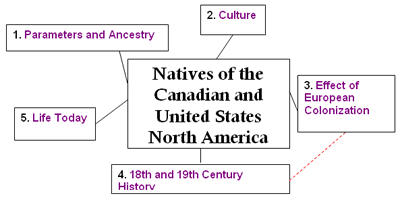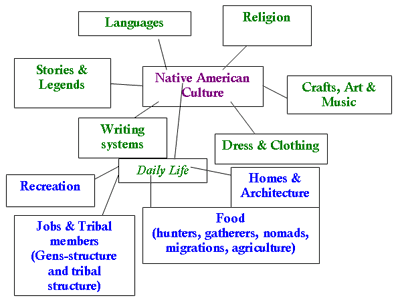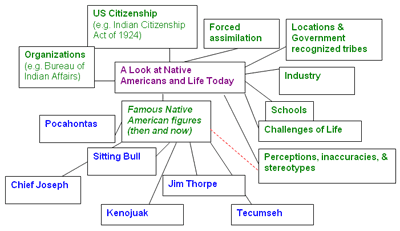
Background
Lesson
Home > Archive > For teachers > Native Americans (S. Studies) > Lesson
![]()
![]()
Students will explore the rich and diverse culture of various Native American groups in North America. In this unit, students will evaluate the history of how and when North American Natives came to the continent, the cultures that formed, the effects of foreign exploration, and the role Native Americans play in society today. Finally, students will explore the controversy regarding the origin of Native Americans.
![]()
The students will be able to:
- Understand how early Native people came to North America.
- Evaluate the cultures of multiple regions of North America Natives.
- Participate in discussions analyzing the effects of foreign exploration upon Native tribes.
- Examine the history and current status of Native Americans as a part of America’s history as a whole.
- Explore past and current perceptions of Native Americans, evaluate the resulting stereotypes, and assess the inaccuracies of such perceptions.
Level: Upper Middle School
Spicy Nodes Teacher Prep: Prepare a nodule for your students to use as an opening framework for this lesson. The nodule below is a possible arrangement of topics of study for this unit.

![]()
![]()
(covers #1 in the main diagram)
![]()
- Ask students, “When you think of Native Americans, what images come to your mind?”
- Present students with the following terms:
- Indian
- Native American
- Indigenous people
- American Indian
- Have students discuss what they think of when they hear each term.
- Discuss each term, how it may have evolved, when it was used, and perhaps why it was used.
- Create a chart to record the definition and perception(s) associated with each term.
- Introduce students to the main SpicyNodes nodule from the Teacher Prep section (or the one you have prepared).
- Have students discuss Nodule #1. Have students brainstorm what they know about how and when the earliest peoples came to North America. Below is an example of the some possible results from such a discussion.
- Divide students into small groups to conduct research on topics related to the origin of the earliest Native Americans (e.g. the Land Bridge theory and the controversy with the theory; the New World Migration model; the history of Paleoamericans; the creation of the Five Nations, and so forth).
- If one group finishes early, they can fill in the SpicyNodes nodules for terminology as discussed in the anticipatory set.
- As students complete their research, their information should be added as branches off of the initial nodules.
- Once all groups have completed their nodules, discuss and share the migration theories and the general history of the earliest people to inhabit North America.
- As a group, determine the six main geographical regions of study. Below is an example of the some possible results from such a discussion.
- In small groups, have students research one of the geographical areas, citing the physical and geographical characteristics of the region, as well as the major tribes to inhabit each area.
- Finally, have students create nodules presenting the findings of their research in #12.
- As a class, create a North American map for the students to attach to the SpicyNodes presentation, labeling tribes in the appropriate areas.

![]()
(covers #2 in the main diagram)
- Engage students in a brainstorming session to discuss everything they know about Native American culture. Use this information to establish the green layer of nodules in the map below as a class.
- Divide students into small groups and assign each group one nodule relating to Native American culture to study. (Assign all of the cultural areas except Daily Life, as that section can get quite expansive)
- Advise students to research their area thoroughly, as cultures varied by tribe and/or region. Encourage students to note geographical variations when discussing their cultural area. Students can be creative in how they organize their research findings. That is, in addition to text, they can attach charts, pictures, and diagrams to their nodule for presentation.
- As students complete their research, have the groups add their completed nodules to the main SpicyNodes presentation.
- With the students back in one group, brainstorm the various elements of Daily Life, and repeat step #2 for students to complete research on the various aspects of daily life for Native Americans. Below is an example of possible results from such a discussion. Again, encourage students to consider how each region varied in these aspects and to highlight the rich cultural distinctions.
- As students complete their research, have the groups add their completed nodules to the SpicyNodes presentation.
- Once all groups have completed their nodules, discuss and share the information students have discovered about the various Native American cultures.

![]()
(covers #3 and #4 in the main diagram)
- Focus the class’ attention on nodules #3 and #4 in the SpicyNodes presentation. Have students present ideas about how and why these two nodules are closely related. (As the teacher can see from the proposed map below, there are many inter-connections amongst these topics.)
- As discussion of student knowledge develops, encourage students to spot the connections and overlaps that result between these two areas of study. Guide the class toward identifying the nodules in green (that is, the main effects of the interactions and the main historical events with which they are already familiar).
- Once brainstorming is completed, if more nodules are needed, you can 1) provide the students with the remaining areas of study you wish for them to research, or 2) if time permits, provide students with time to conduct some research to identify the other nodules you wish them to consider. Below is an example of possible results from such a discussion.
- With the class, complete the map of nodules for research in this area.
- Break the students into small groups to conduct research about the nodules in green. If more information is uncovered, have students add the appropriate nodules and information to their area.
- As students complete their research, their information should be added as branches off of the initial nodules.
- Revisit the arrangement of the nodule map below. Discuss with students what other connections can be made or what areas should be moved, changed, or expanded.
- What does the complexity of this map suggest about the effects of European colonization on Native Americans?

![]()
(covers #5 in the main diagram)
- Have students share what they know about Native Americans in recent years and today.
- Brainstorm topics of discussion regarding “current” studies of Native Americans to create the green layer of nodules below. Below is an example of possible results from such a discussion.
- In smaller groups, have students research an assigned area of study (except for the Famous Native nodes, as this will be a separate assignment in the final section) and complete their nodule with the information they know and discover.
- As students complete their research, have students enter their information into the appropriate nodule.
- When research is complete, have students present and discuss their information.
- Focus students on the final nodule below (in italics) for famous Native American figures. Have students brainstorm names of famous Native Americans that they already knew or discovered during their research.
- Create nodules for the names the students identify, and have students complete individual or small group research on a famous Native American of interest to them.
- As students complete their research, have students enter their information into the appropriate nodule.

![]()
- Have students revisit the chart from the opening of the unit that listed the terminology used throughout history to refer to Native Americans.
- Discuss with students how they feel about the terms now versus how they felt at the beginning of the unit. Here are some other possible topics for discussion:
- What were you surprised to learn about Native Americans during this unit?
- How do you feel about the stereotypes facing Native Americans in our country?
- What are some issues facing Native Americans today?
- What do you think was/is the most significant contribution of Native Americans?
- In a private journal, revisit the question asked at the start of the unit, “When you think of Native Americans, NOW what images come to your mind?” Have students write a reflective response about how their perspectives have changed.
![]()
- Monitor participation during whole class discussion and small group work.
- Students work cooperatively to brainstorm and develop nodules as well as research, record, organize, and present information.
- Students clearly include all points of their plan in the development of their nodes.


